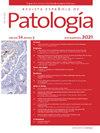原发部位不明的腰腹膜分流术后的腹膜癌:病例报告及文献复习
IF 0.5
Q4 Medicine
引用次数: 0
摘要
原发部位不明的癌症(CUP)常常表现出不典型的临床表现,这给确定原发肿瘤带来了挑战。本文讨论了一例 CUP 脑转移患者,尸检后最终诊断为肺多形性癌。临床上,尽管影像学检查最初提示原发性肺肿瘤,但腹膜癌肿的发生降低了对原发性肺肿瘤的怀疑。然而,患者之前曾接受过腰腹部(LP)分流术。除了本病例报告外,我们还对有关脑室腹腔(VP)分流和腰腹腔分流在肿瘤转移扩散中的作用的文献进行了系统回顾。虽然原发性脑肿瘤通过脑室腹腔分流管或腹腔分流管扩散的情况非常罕见,但这种现象在继发性肿瘤中仅有两次报道。本文章由计算机程序翻译,如有差异,请以英文原文为准。
Peritoneal carcinomatosis after lumboperitoneal shunt in a patient with a cancer of unknown primary site: Case report and review of the literature
Cancer of unknown primary site (CUP) often presents with atypical clinical behaviours that make identifying the primary tumour challenging. In this paper, we discuss the case of a patient with brain metastases from a CUP, which was ultimately diagnosed as pleomorphic carcinoma of the lung following autopsy. Clinically, the development of peritoneal carcinomatosis had reduced suspicion of a primary lung neoplasm, despite imaging tests initially suggesting this. However, the patient had previously undergone lumboperitoneal (LP) shunt insertion. The sequence of clinical events and autopsy findings strongly indicated that the LP shunt facilitated the metastatic spread.
In addition to this case report, we provide a systematic review of the literature on the role of ventriculoperitoneal (VP) and LP shunts in the metastatic dissemination of tumours. Although the spread of primary brain tumours via VP or LP shunts is rare, albeit well-documented, this phenomenon has been reported only twice for secondary tumours.
求助全文
通过发布文献求助,成功后即可免费获取论文全文。
去求助
来源期刊

Revista Espanola de Patologia
Medicine-Pathology and Forensic Medicine
CiteScore
0.90
自引率
0.00%
发文量
53
审稿时长
34 days
 求助内容:
求助内容: 应助结果提醒方式:
应助结果提醒方式:


